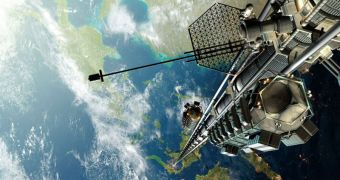The 2009 Space Elevator Power-Beaming Challenge Games have recently been rescheduled for November 4, a few months after the initial term, on July 14, the Spaceward Foundation has announced. The competition will therefore take place in about three weeks, at the NASA Dryden Flight Research Center (DFRC), within the confines of the Edwards Air Force Base (EAFB), in Southern California. The delay was caused by the technical difficulties that experts met when advance-testing the suspended cable system for the robotic climbers, Space Fellowship reports.
During the competition, a one-kilometer-long cable will be suspended from a hovering helicopter, and the four teams that have announced their participation will try to make their laser-guided robots climb all the way to the top. If all of the teams manage to climb this high, then they will all be called winners, the organizers say. The goal is to test whether the technology we would need to climb up an orbit-headed cable exists, or if it's still some time away.
The Space Elevator Power-Beaming Challenge has been taking place every year for the past four years, and each edition has seen increasingly higher demands. For instance, in order to be eligible for this year's $2-million prize, the teams will not only have to get their robots to the top, but will also need to do so at a speed of at least five meters per second. Thus far, none of the teams that participated in the contest managed to win any money off its robots.
The Spaceward Foundation is able to host the competition with financial support from the American space agency's Centennial Challenges program. The project awards innovation through competition, and NASA hopes to find some really good designs this way. “Centennial Challenges explores high-risk, high-payoff ideas using technology prize competitions to encourage and reward innovation,” NASA CC Program Manager Andrew Petro said.
“We’re happy to see that the Power-Beaming Challenge has matured to its current level, and anticipate technology innovations in power beaming that may be useful for NASA’s exploration missions and in other applications,” he added. If a space elevator is obtained, it could considerably change science. Electric vehicles would ferry scientists and their experiments directly to orbit, along a thick wire. This would also eliminate the negative impact that rocket launches have on the environment.

 14 DAY TRIAL //
14 DAY TRIAL //